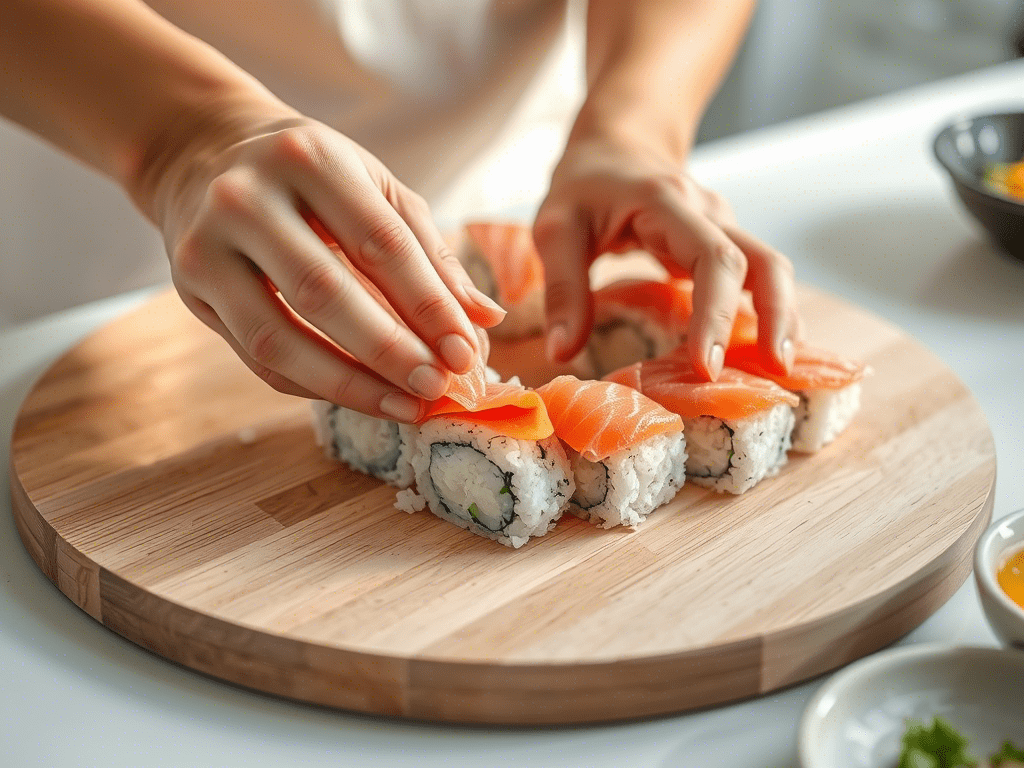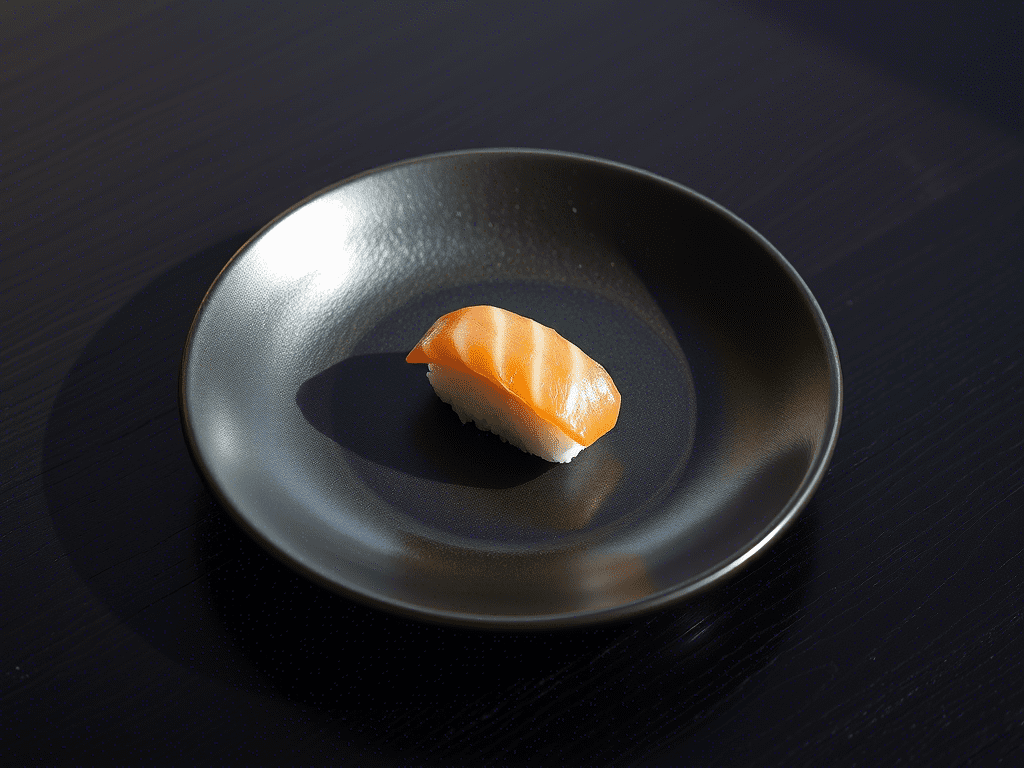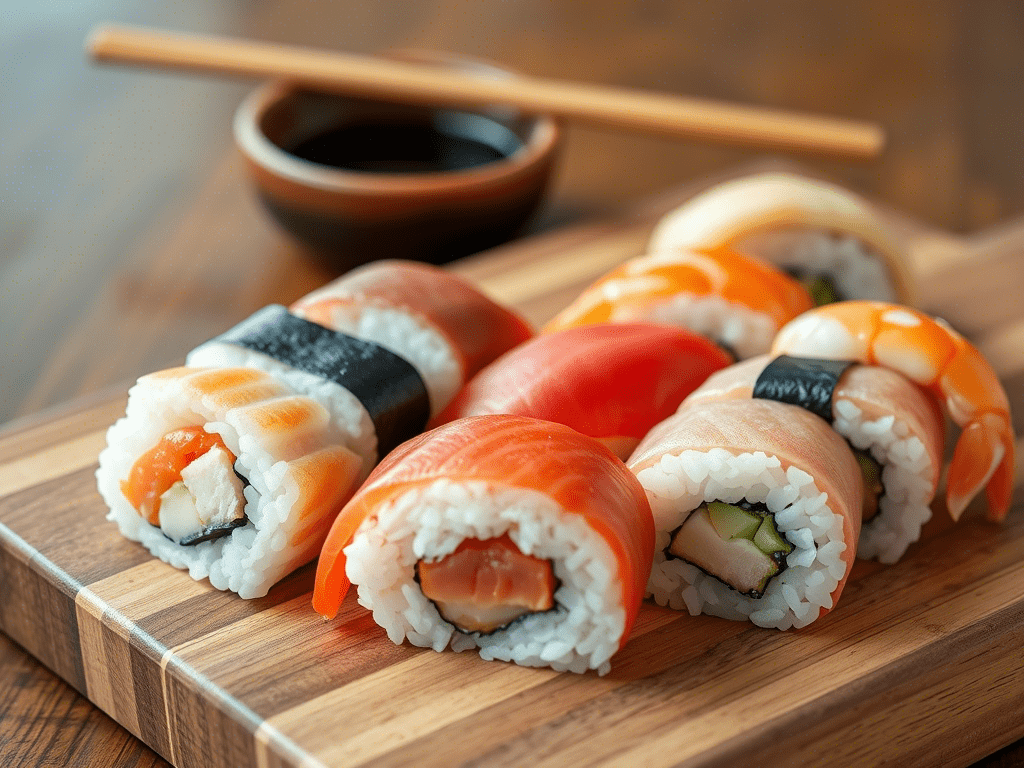7 Delightful Nigiri Facts Every Sushi Lover Will Appreciate
Sushi has become a global favorite, but among the endless rolls and fusion creations, nigiri remains one of the purest expressions of Japanese culinary art. It may look simple—just a slice of fish on rice—but the craft, precision, and tradition behind it are anything but ordinary.
Whether you’re a sushi beginner or someone who knows the difference between toro and tamago, understanding what is nigiri gives you a deeper appreciation for the balance and beauty that defines Japanese cuisine.
In this article, we’ll break down the meaning of nigiri, explore how it compares to sashimi, highlight different types you’ll find at sushi counters, and share tips for eating it the right way—plus how to make your own if you’re feeling adventurous.
Table of Contents
What Is Nigiri?
Nigiri is a traditional type of sushi that’s as elegant as it is simple. At its core, it consists of a hand-pressed mound of vinegared rice topped with a thin slice of raw or cooked fish. No rolls, no seaweed wrapping—just the essentials. The word nigiri comes from the Japanese verb nigiru, meaning “to grasp” or “to hold,” referencing how the rice is gently formed by hand.
What makes nigiri sushi unique is its minimalist construction. There are no flashy fillings or sauces—just perfectly seasoned rice, ultra-fresh seafood, and sometimes a tiny bit of wasabi tucked between the two. A small strip of nori (seaweed) may be added to hold looser toppings like egg (tamago) or eel (unagi) in place.
People often ask, “what is nigiri exactly?” or “what’s the difference between nigiri and other types of sushi?” The answer is simplicity. Nigiri isn’t rolled; it isn’t overloaded. It celebrates the quality of each individual ingredient, making it one of the most respected forms of sushi in Japanese culture.
It’s the kind of dish that lets the freshness of the fish shine. And when made well, each bite offers a subtle balance of flavor, texture, and technique.
Nigiri vs Sashimi – What’s the Difference?

A common question at sushi restaurants is: nigiri vs sashimi—aren’t they basically the same thing? The short answer: not quite.
While both showcase raw fish, the key difference lies in the rice. Nigiri is composed of hand-pressed vinegared rice topped with sliced fish, sometimes with a bit of wasabi between the two. Sashimi, on the other hand, is simply sliced raw fish served on its own—no rice, no garnish, just pure fish.
Visually, they’re also presented differently. Nigiri comes in compact, bite-sized pieces, often with a touch of flair like a seaweed wrap or a gentle sear. Sashimi is more minimalistic, served as thin slices arranged neatly on a plate, often accompanied by daikon radish or shiso leaves.
When deciding between nigiri sushi and sashimi, it often comes down to texture and fullness. Nigiri offers a more complete bite with the balance of rice and seafood, while sashimi is ideal for those who want a cleaner, more focused experience of the fish itself.
So next time you’re ordering, knowing the difference helps you match the dish to your craving—whether you’re in the mood for something hearty and balanced or something pure and direct.
What Makes Nigiri Special?
At first glance, nigiri might seem like the most basic option on a sushi menu. But its simplicity is what gives it such a distinct and refined appeal.
The preparation of nigiri demands precision. Each piece is shaped by hand, not molded or machine-pressed. The rice must be seasoned just right—slightly warm, with the perfect balance of vinegar and texture to hold its shape without being dense.
The fish on top isn’t just any cut. It’s usually the best part of the fillet—thinly sliced and carefully placed to drape elegantly over the rice. Sometimes, a tiny brush of soy sauce or a hint of wasabi is added, but never enough to overshadow the natural flavor of the seafood.
This type of sushi celebrates restraint. It asks the chef to show their skill through restraint and harmony, not extravagance. It asks the diner to slow down, appreciate the freshness, and enjoy the quiet balance in every bite.
What truly sets nigiri apart is how it delivers so much flavor with so little flash. It’s the art of doing more with less.
Types of Nigiri You’ll See at Sushi Bars
Walk into any sushi restaurant, and you’ll find a colorful display of nigiri options that range from familiar to adventurous. Each one brings a different texture, flavor, and character to the table.

Here are some of the most popular and widely loved varieties:
Tuna (Maguro)
A classic choice. Lean and meaty with a clean flavor, often the go-to for beginners.
Fatty Tuna (Toro)
More luxurious and rich in texture. Often served in high-end sushi spots due to its melt-in-your-mouth quality.
Salmon (Sake)
Bright orange, buttery, and smooth. Sometimes lightly seared for added depth.
Shrimp (Ebi)
Cooked and slightly sweet, it’s usually paired with a touch of wasabi and a stripe of seaweed to hold it in place.
Egg Omelet (Tamago)
A sweet, layered omelet often served cold. Great for those who prefer non-seafood options.
Freshwater Eel (Unagi)
Grilled and glazed with a slightly smoky, sweet soy-based sauce. Usually served warm.
Squid or Octopus (Ika / Tako)
Chewy and mild in flavor. Often paired with a light garnish or sauce.
Each type of nigiri offers something different—whether it’s buttery softness, firm bite, or bold flavor. It’s what makes this style of sushi so fun to explore. You can build your plate based on mood, texture preference, or simply curiosity.
Can You Make Nigiri at Home?
Absolutely—you don’t need to be a sushi chef to enjoy fresh, homemade nigiri. While making it perfectly like a pro takes time and practice, creating your own version at home is totally doable, even for beginners.

What You’ll Need
- Sushi rice: Short-grain Japanese rice, seasoned with rice vinegar, sugar, and salt
- Fresh fish: Sushi-grade tuna, salmon, or cooked shrimp (buy from a reputable source)
- Wasabi paste (optional)
- Sharp knife: For clean fish slices
- Bowl of water: To keep your hands from sticking when shaping rice
- Cutting board and clean surface
Basic Steps:
- Cook and season your rice. Let it cool until slightly warm.
- Slice your fish into thin, uniform pieces.
- Wet your hands, shape a small ball of rice (about the size of two fingers), and press gently—not too tight.
- Add a tiny dab of wasabi (if using), then place the fish slice on top and press lightly to bind it together.
That’s it—you’ve made your first nigiri. It won’t be perfect, but that’s part of the fun. With every attempt, you’ll get better at shaping, slicing, and balancing flavors.
Want to level up? Invest in a sushi-making kit, try new toppings, or pair your creations with miso soup or pickled ginger. It’s a hands-on culinary experience that’s both rewarding and tasty.
The Beauty of Simplicity

What’s striking about nigiri isn’t just the ingredients—it’s the experience. The subtle pressure of the chef’s hand as they mold the rice. The way each slice of fish is carefully selected, trimmed, and placed. The temperature—just warm enough for the rice to hold its shape, just cool enough for the fish to maintain its delicate texture. These little details are invisible to the eye, but felt with every bite.
Nigiri doesn’t rely on heavy sauces, bright colors, or elaborate garnishes. It invites you to focus—on the temperature, the chew, the smoothness of the fish. Even dipping it in soy sauce, if done properly, becomes part of the ritual.
In a world where food is often rushed or over-complicated, nigiri reminds us of the value of restraint. It asks you to slow down, to taste intentionally, and to connect with the tradition that shaped this iconic bite over centuries. And perhaps that’s why it never goes out of style—because it doesn’t chase trends, it honors precision.
A Quiet Moment in Every Bite
There’s something meditative about eating nigiri. No noise, no distractions—just a single, intentional bite that invites your full attention. It’s not about being impressed. It’s about being present.

In that moment, you notice everything: the softness of the rice as it yields under gentle pressure, the coolness of the fish, the way the flavors blend without trying to compete. Even the smallest actions—dipping it lightly into soy sauce, lifting it with your fingers—feel calm and deliberate.
Sitting at the counter of a quiet sushi bar, you might catch the chef’s rhythmic movements. They’re not rushing. They’re not performing. They’re simply doing what they’ve done a thousand times, with care. And somehow, that care makes its way into your hands, your mouth, your memory.
Nigiri doesn’t fill you up—it stays with you. In the stillness of its simplicity, it leaves a subtle mark, like a well-told story with no need for a twist at the end.
Common Mistakes to Avoid
Nigiri might look simple, but small missteps can make the experience less enjoyable. Here are a few common mistakes to watch out for—especially if you’re making or eating it for the first time.
Dipping the Rice Side in Soy Sauce
This is sushi’s number one rookie move. When you dip the rice side, it absorbs too much soy sauce and falls apart. Always flip and dip the fish side lightly instead.
Overloading with Wasabi
Too much wasabi can overpower the delicate flavor of the fish. Most chefs already add the right amount between the rice and the topping. If you’re adding your own, go easy.
Using the Wrong Fish
If you’re making it at home, make sure to use sushi-grade fish from a trusted source. Not all raw fish is safe to eat, and freshness is key to both flavor and safety.
Pressing the Rice Too Hard
Nigiri rice should be soft and airy—not packed tight like a rice brick. Use gentle pressure when forming the shape. The goal is for it to hold together just enough for one clean bite.
Eating It in Multiple Bites
Nigiri is designed to be eaten in one bite to preserve the harmony between rice and fish. If the piece is too big, take a clean two-bite approach, but don’t let it fall apart.
By keeping these tips in mind, you’ll respect the tradition and enjoy the experience the way it was intended—balanced, elegant, and deeply satisfying.
Is Nigiri Healthy?
Nigiri isn’t just delicious—it can also be a smart, nutritious choice, especially when compared to heavier, fried, or sauce-heavy sushi rolls. But like any food, its health value depends on how it’s prepared and what you pair it with.
At its core, nigiri is a lean protein on top of vinegared rice. Most commonly, it features raw fish like tuna or salmon, both of which are rich in omega-3 fatty acids—great for heart and brain health. Shrimp, scallops, and even egg (tamago) offer variety without a huge calorie load.
The rice portion is usually small, about two fingers’ worth, which helps keep carbs moderate. The vinegared rice also aids digestion and adds subtle flavor without needing sauces. However, if you’re watching carbs or sugar intake, know that sushi rice contains a bit of sugar and can add up over multiple pieces.
Pro Tips to Keep It Clean:
- Choose fatty fish like salmon or tuna for omega-3s
- Go easy on soy sauce, especially if watching sodium
- Limit fried or glazed nigiri (like eel with sweet sauce)
- Pair with miso soup or seaweed salad to balance your meal
- Avoid processed wasabi loaded with food coloring or additives
One of the best things about nigiri is portion control. Each piece is its own unit, so it’s easy to eat mindfully. Two or three pieces make a light snack. Five or six with soup and a salad can be a full, balanced meal.
So yes—when chosen wisely, nigiri is one of the cleanest, most satisfying sushi options out there.
FAQ – Nigiri Sushi
Can nigiri be eaten warm or cold?
Traditionally, the rice in nigiri is served slightly warm while the fish is cool or at room temperature. This contrast enhances texture and flavor. Cold rice or overly chilled fish can dull the experience, so the ideal is a fresh, just-assembled piece—not straight from the fridge.
What fish is safest to eat raw on nigiri?
Tuna, salmon, and yellowtail are among the most commonly used and widely considered safe when sushi-grade. Sushi-grade means the fish has been frozen to kill parasites, meeting safety standards. If you’re buying fish for homemade nigiri, always choose reputable suppliers and avoid fish labeled “previously frozen” without sushi-specific certification.
Is nigiri gluten-free?
It can be, but watch the soy sauce. Most soy sauces contain wheat, so you’ll want to opt for a gluten-free version like tamari. Also, some vinegars and prepared wasabi can contain additives, so read labels if you’re sensitive or celiac.
Why does nigiri sometimes have a seaweed strip around it?
That strip of nori (dried seaweed) helps hold toppings that are more delicate or likely to fall off—like sweet omelet (tamago), eel (unagi), or cooked shrimp (ebi). It also adds texture and an umami punch to each bite.
What’s the difference between nigiri and hand rolls or maki?
Nigiri is shaped rice topped with fish, no rolling involved. Hand rolls (temaki) are cone-shaped seaweed wraps filled with rice, fish, and vegetables. Maki are rolled sushi with rice and filling wrapped in seaweed and sliced into pieces. Each has its own style, but nigiri keeps it minimal and elegant.
Can I eat nigiri without soy sauce or wasabi?
Yes—and in fact, many sushi chefs prefer you do. The fish is often already seasoned or paired with a dab of wasabi. Too much sauce can cover up the flavor of high-quality fish. Always taste a piece as-is before reaching for the soy dish.
Final Thoughts
Nigiri may look simple, but beneath that clean presentation lies a deep tradition of craftsmanship, respect for ingredients, and attention to detail. Whether you’re trying it at a sushi bar or making it at home, nigiri offers one of the purest and most satisfying sushi experiences out there.
Its beauty lies in balance—between texture and taste, freshness and simplicity, tradition and creativity. It’s no wonder that for many sushi lovers, nigiri is the gold standard.
If you’ve never tried it before, now’s the time to give it a go. And if you’re already a fan, consider exploring new types or even crafting your own. Either way, there’s always something new to discover in a dish that’s been mastered over centuries.
From GrowVibe
- Jello Shots Guide – Fun Party Recipes
- Orange Creamsicle Cocktail Recipes
- Snow Cream Recipe – Sweet & Cool
Recommended Tools
- Sushi-Making Kit – Includes molds, rollers, and guides for perfect nigiri at home
- Wasabi Paste (Authentic Japanese) – Clean, spicy, and perfect for sushi
- Chopsticks Set – Reusable, elegant designs for presentation
- Bamboo Sushi Tray – Serve your nigiri like a pro
Respect the rice, honor the fish, and enjoy the experience—nigiri is more than food. It’s an art form you can taste.





